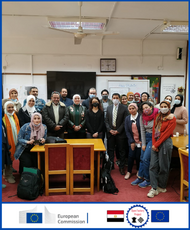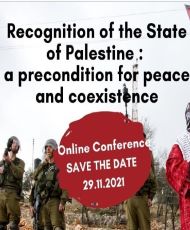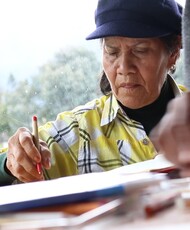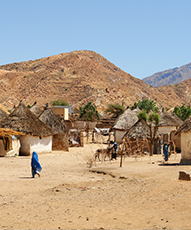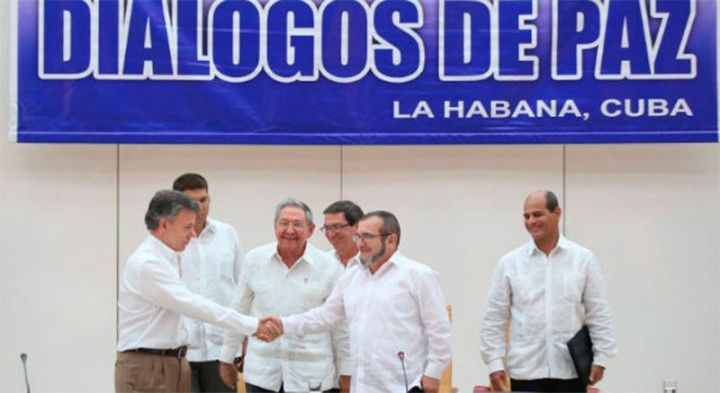
Since 1964 have died thousands of Colombians who were part of the rebel army and armed groups fighting in the forest, during what is defined the last largest armed civil conflict in Latin America.
The Revolutionary Armed Forces of Colombia (FARC) have agreed to observe a ceasefire from midnight local time on August 28th, 2016, under the orders of their leader Timoleon Jimenez directly from Cuba, where peace negotiations are kept.
On the other hand, already on August 25th, 2016, the Colombian President Juan Manuel Santos ordered to the national armed forces not to intervene militarily against the FARC.
The FARC had already declared in July the unilateral cease-fire, but now both parties agree to end the conflict.
The final agreement will focus on the following points. On rural matters, which is one of the triggers of the Colombian conflict, the agreement revolves around three axes: land management, which in Colombia has a bad production allocation, with a prevalence of landowners; the social order of the property, with the introduction of a Rural Land Registry and the creation of a fund which grants property rights well defined for small farmers; rural development geared to the territory, which is based on a plan for the supply of public goods and merit, from infrastructure to ensure the security of water resources, from education to public services.
On justice, it was essential the advice of international parties, but also of Colombian experts, since it is the first case of an agreement under the umbrella of the International Criminal Court, which requires special guarantees in the presence of human rights violations. Congress will pass a law of pardon and amnesty particularly wide, but excludes any violation protection by the ICC.
As for the FARC, the next step will be to turn itself into a “legal political movement”. In this regard, the agreement provides for a system of guarantees for the viability of the latter (and the opposition forces), to prevent a repeat of the tragic Colombian history of systematic human rights violations. This will have two terms, the new party will have at least five representatives in the House and five in the Senate, and the agreement provides for the revision of the current statute that grants legal status to the parties only when they reach a voting quorum.
There is a strengthening of community participation spaces, such as local radio and the control mechanisms citizens against corruption. It also creates an alert system, monitoring and intervention that should guarantee the political participation especially in the territories.
To transform itself into a political party, the guerrillas will have to converge in 31 points of the specifically identified Colombian territory, where, under UN supervision, will allow the identification and delivery of weapons, thereby initiating a demobilization process. Santos told the newspaper El Espectador that all guerrillas who refuse to disarm, will be persuaded to do it by all means possible the state. The FARC must abandon any link with drug trafficking, in exchange for an intensification of the fight by the Government against other illegal actors, such as various forms of paramilitarism, who may try to invade the space left by the guerrillas. The agreement provides for a change in legislation that affects consumers and small producers of the coca leaf, to focus on the business leaders and influence on these processes. For the coca leaf, the plan includes both the regulated production is the voluntary exchange of the cultivation with the Government support. Finally, it creates a bipartite Commission for the implementation and monitoring of the agreements, with a potential duration of ten years. Again, international actors are identified, they can take the place of impartial supervisors of individual points. The agreement includes a table that specifies the name of the charge, ranging from the US to, by the UN to Sweden.
By reasoning a little in a baroquian way, the agreement has already been constitutionally armored thanks to an interpretation whereby, in the case of human rights, would be covered by the Geneva Convention of 1949. However, the insistence of President Santos , the Colombian people is called upon to rule on October 2nd by voting Yes or No to the final text. The mechanism is called the plebiscite, requires a minimum quorum and is formally binding only to the President, in fact, the victory will ensure the necessary political legitimacy, while not open a political crisis.
The conflict has lasted half a century and has been disastrous: 260,000 are reported dead, 45,000 missing people and 6.9 million people who have had to leave their homes.
Jimenez said he wanted to work with all those who were over rivals, considering compatriots, so as to jointly create a new Colombia.

